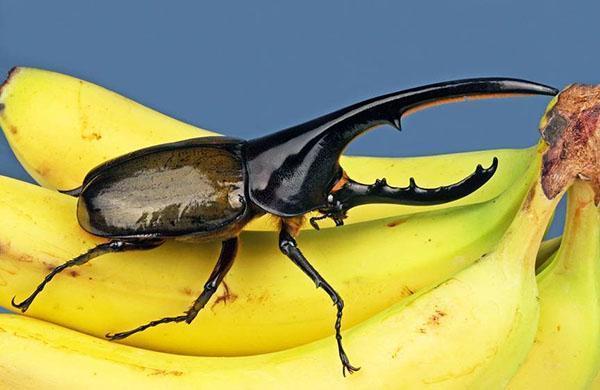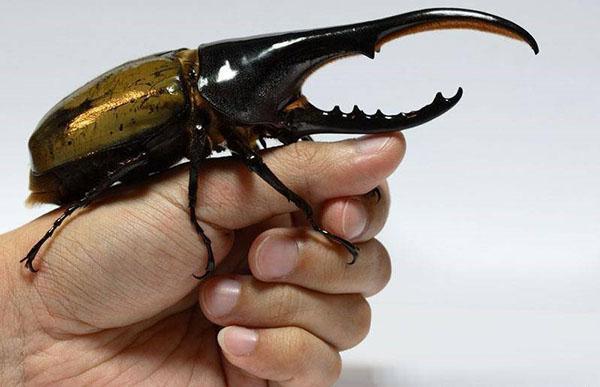The giant among insects - the hercules beetle
 Insects are another class of the animal kingdom. Numerous, varied and completely unknown. It contains butterflies of unusual color and size, frightening spiders, giant beetles. Among the latter, the Hercules beetle is surprising. Yes Yes. This is one of the largest representatives, conquering not only with its size, but also with its unusual appearance.
Insects are another class of the animal kingdom. Numerous, varied and completely unknown. It contains butterflies of unusual color and size, frightening spiders, giant beetles. Among the latter, the Hercules beetle is surprising. Yes Yes. This is one of the largest representatives, conquering not only with its size, but also with its unusual appearance.
Prevalence

Hercules is native to South America. He also lives in Bolivia, Venezuela, the Caribbean, Ecuador, Peru, Central American regions, the Dominican Republic, Mexico, Bolivia, Antilles, Colombia, Brazil, Panama, Guadeloupe. Favorite places are humid forests of subtropical and tropical zones, where a lot of greenery and fruits grow. But sometimes during wet periods they can be found in lowland and mountain forests. They prefer to live on the forest floor. The larvae live in rotting wood, which is also food, while the adults prefer to live at the foot of the trees.
Description
 The insect has both female and male individuals, so different from each other that they are classified as a different genus. The photo of the Hercules beetle shows that its appearance is very unusual. The insect is shiny, the elytra are yellow-olive, olive and yellow. Head and pronotum black. The back may also have spots. The color changes depending on humidity.
The insect has both female and male individuals, so different from each other that they are classified as a different genus. The photo of the Hercules beetle shows that its appearance is very unusual. The insect is shiny, the elytra are yellow-olive, olive and yellow. Head and pronotum black. The back may also have spots. The color changes depending on humidity.
So, there are individuals with a blue-gray color. The head is small. It is crowned with tendrils, consisting of 10 segments. The legs of the insect are long, strong, have claws with which the beetle clings and climbs plants. The front legs are also intended for digging, and thanks to them the insect burrows into the litter.
Adult insects
 The male individual can reach 16 cm in size and all due to the huge outgrowth on the head and pronotum - the main advantage of the beetle, which is used in the fight for the female. The “head” horn has teeth, while the horn located on the pronotum bends downward and has brown villi on the underside. Its length may be greater than the insect itself. The beetle has well-developed wings.
The male individual can reach 16 cm in size and all due to the huge outgrowth on the head and pronotum - the main advantage of the beetle, which is used in the fight for the female. The “head” horn has teeth, while the horn located on the pronotum bends downward and has brown villi on the underside. Its length may be greater than the insect itself. The beetle has well-developed wings.
The wingspan of an adult can reach 22 cm.
Females are much smaller and grow up to 8 cm. They have no horns. The elytra are dark, and the entire body is covered with red hairs.
Larva
 The size of the larvae is impressive and can reach 18 cm.If you look closer, you can see a soft, sclerotized white body, slightly covered with hairs. There is a black head. In an adult larva preparing for pupation, the color changes to brown. Its body has a peculiar, 12-segmented structure with three pairs of chest legs. Dark spiracles are located on the lateral sides. The mouth of the larva is formed according to the "gnawing" type. The upper jaw is triangular and has two teeth inside.
The size of the larvae is impressive and can reach 18 cm.If you look closer, you can see a soft, sclerotized white body, slightly covered with hairs. There is a black head. In an adult larva preparing for pupation, the color changes to brown. Its body has a peculiar, 12-segmented structure with three pairs of chest legs. Dark spiracles are located on the lateral sides. The mouth of the larva is formed according to the "gnawing" type. The upper jaw is triangular and has two teeth inside.
Food
Hercules feeds on overripe or ripe fruit pulp. It is noteworthy that the insect can eat the same fruit until it has completely sucked out all the nutritious juices from it. As for the larvae, they eat wood fibers and rotten wood, in which they live.If it is necessary to search for a new source of food, beetles are able to fly over long distances.
Development
 In general, an adult can live 6-10 months. After mating, the female lays a large number of eggs in the rotten wood, about 100 eggs. After 4-6 weeks, a larva develops from them. In this phase, she spends 1.5-2 years. Feeding on rotten wood, the larva is constantly growing and grows up to 18 cm in length. Moreover, its weight can be 100 g. A very impressive size, more than a palm. After the time allotted for this stage, the larva prepares a house, in which one side consists of pressed soil, and turns into a pupa.
In general, an adult can live 6-10 months. After mating, the female lays a large number of eggs in the rotten wood, about 100 eggs. After 4-6 weeks, a larva develops from them. In this phase, she spends 1.5-2 years. Feeding on rotten wood, the larva is constantly growing and grows up to 18 cm in length. Moreover, its weight can be 100 g. A very impressive size, more than a palm. After the time allotted for this stage, the larva prepares a house, in which one side consists of pressed soil, and turns into a pupa.
After about 1.5 months, an adult beetle crawls out of it, and the life cycle starts again.
Hercules is very unusual! He is able to carry with him a load that exceeds his own body weight by 850 times. Translated into "human" proportions, with such strength, we would have to lift a weight of 65 tons.
Beetle and man
 The beetle is also good because, despite its very formidable appearance, it is completely harmless to humans and agriculture. Since it feeds mainly on overripe fruits, and the larvae process rotten wood, the insect does not harm the crop. In addition, the beetle is not poisonous and does not tolerate diseases.
The beetle is also good because, despite its very formidable appearance, it is completely harmless to humans and agriculture. Since it feeds mainly on overripe fruits, and the larvae process rotten wood, the insect does not harm the crop. In addition, the beetle is not poisonous and does not tolerate diseases.
Some insect lovers even buy it, keep it in containers, multiply it and hold it in their hands without fear.
The cost of rolled oats is high - $ 120 per piece.
If you nevertheless decide to get yourself such an unusual domestic insect, then you can buy it in special nurseries or forums. But keep in mind that for proper development, the beetle will need to be provided with proper care and conditions of detention.
On the verge of extinction
Unfortunately, Hercules is gradually disappearing. This is due to:
- Environmental pollution.
- Decrease in habitat of beetles due to human activity and constant cutting down of trees suitable for habitation and feeding of larvae.
- In addition, the Hercules themselves and their horns are widely used in folk medicine.
- The appearance and size of the insects are original. Unsurprisingly, they became collectibles.
- The high cost prompts people to catch bugs for sale.
As you can see, despite its frightening appearance, the Hercules beetle is completely harmless, not dangerous, very interesting, is one of the largest representatives of its kind and has tremendous strength.